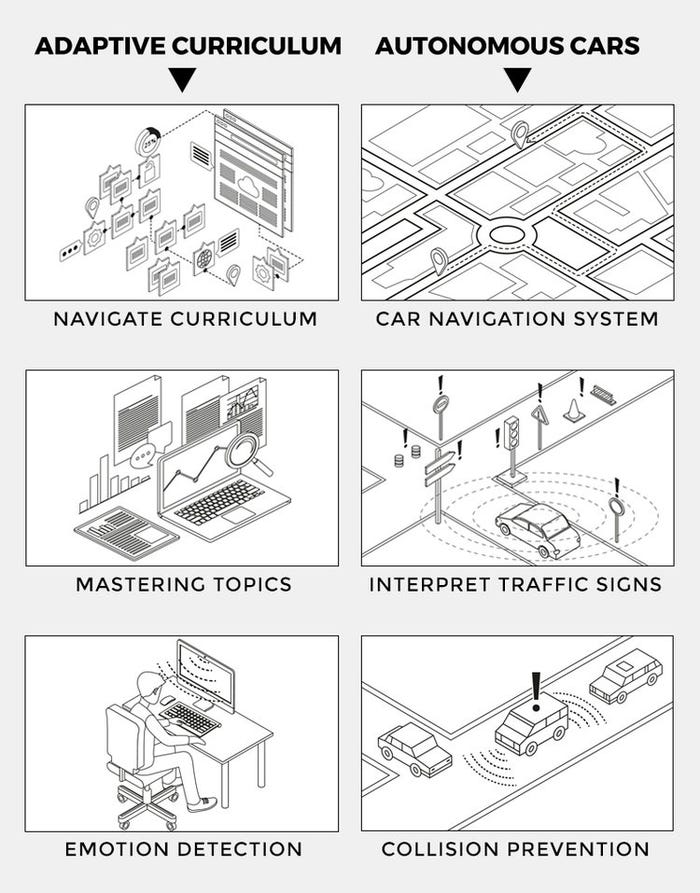Netflix For Education? Here's The Autonomous Car For Education
January 26, 2018

Creating a Netflix for education may sound appealing to many, but Netflix falls short as a guiding example for personalized learning solutions. That is because it can’t mimic education guided by a human teacher. However, comparing technology with human-like performance is not relevant today. The relevant question is how technology can augment our teachers, to make use of their valuable time in a better way. I will use the self-driving car as a guiding example for the type of personalized learning systems that 21st century education needs.
In his blog post, Jay Lynch argues that creating personalized learning is about much more than trying to create the Netflix of education. A personalized learning system, he describes, must enhance the emotional and personal connection between learners and teachers, rather than obviate it.
Most people, including myself, will not find it difficult to agree with Jay Lynch on the part that Netflix falls short as a guiding example for education. However, his deeper reasoning seems to be that (Artificial Intelligence) algorithms cannot replace teachers. Although I am inclined to agree with this idea as well, I believe that Jay Lynch does not take into account a critical challenge of 21st century education: the shortage of teachers.
The Shortage of Teachers Is A Critical Challenge For 21st Century Education
Education needs to cater a growing demand for education worldwide while there is insufficient teaching capacity. From this perspective, the question whether algorithms will be able to replace teachers, is not relevant anymore. The real question we need to ask ourselves is how technology help mitigate the shortage of teachers. The answer to this, in short, lies in the use of Artificial Intelligence to augment the reasoning of human teachers.
Augmenting essentially means that certain teaching tasks are being automated to scale. For example, automating the decision on what learning material is best for individuals at a certain point in time, given desired learning outcomes. And today, Artificial Intelligence is capable of doing just that: human-like reasoning and decision making in the context of education.
Related: How You Can Bridge The AI Skills Gap In 2018
Artificial Intelligence To Augment The Reasoning Of Human Teachers
Self-driving cars are currently being developed that will take us from A to B in a safe, reliable and efficient way. Such cars do not only rely on a navigation system, they must also interpret and apply traffic rules and monitor their physical surroundings. In other words, they simultaneously use multiple intelligent, and interconnected systems. If this all works, the idea is that the driver can spend time on other things besides controlling the vehicle. With current autonomous cars, the driver can however still take back full control at any time.
Now let’s examine the analogy with education. Our self driving car for education needs to guide learners through a curriculum in a safe, reliable and efficient way. It must also do more than just navigate through learning material, it must be able to interpret and apply pedagogic rules. Finally it must be able to monitor the students physically and emotionally. The picture below illustrates the analogy.

In the analogy, multiple intelligent systems work together to support the learning journey. At the basis there is a knowledge graph that is used to recommend the optimal learning path, similar to how a navigation system recommends the best route depending on your location and destination. Simultaneously, a natural language processing system can be used to interpret and resolve learning needs for the situation at hand, such as text comprehension in a mathematics exercise. This is similar to how besides navigating, an autonomous car should be able to work out traffic situations. Last but not least, an emotion detection system runs on the background to detect whether or not the student is positively engaged with the task at hand can intervene when needed.
Multiple Intelligent Systems Work Together To Support The Learning Journey
With a multi-layered decision and recommender system that is capable of more than navigation only, I expect that teachers will gain time to build the personal and emotional connection with the learners.
Although there is enough reason to believe that the autonomous car for education can be created with current A.I. technology, for now the autonomous car for education is a vision. A vision on how we can augment the teachers with A.I. in order to educate their students in lesser time, in a satisfactory manner.
Original post: https://360.edia.nl/360ai-blog-collection/https/the-autonomous-car-for-education.
This article is part of our ‘Future of Work’ series for January 2018. Contact [email protected] for more information about how you can contribute or get involved.

Jaeques Koeman is the CEO and Co-Founder of EDIA, a Dutch edtech company specializing in the application of AI to education.
About the Author(s)
You May Also Like


.jpg?width=700&auto=webp&quality=80&disable=upscale)
.jpg?width=700&auto=webp&quality=80&disable=upscale)
.jpg?width=700&auto=webp&quality=80&disable=upscale)
.jpg?width=300&auto=webp&quality=80&disable=upscale)
.jpg?width=300&auto=webp&quality=80&disable=upscale)
.jpg?width=300&auto=webp&quality=80&disable=upscale)

